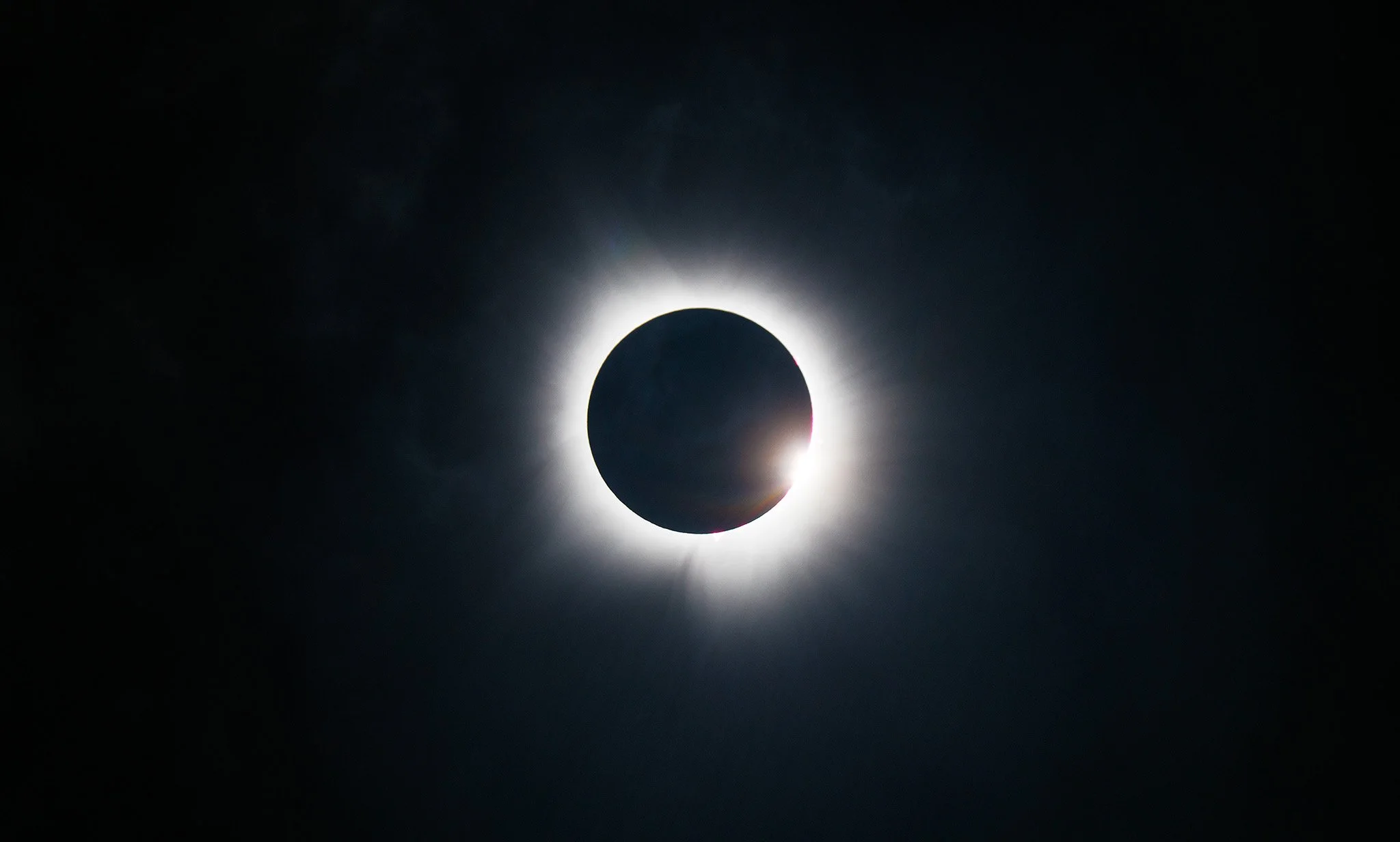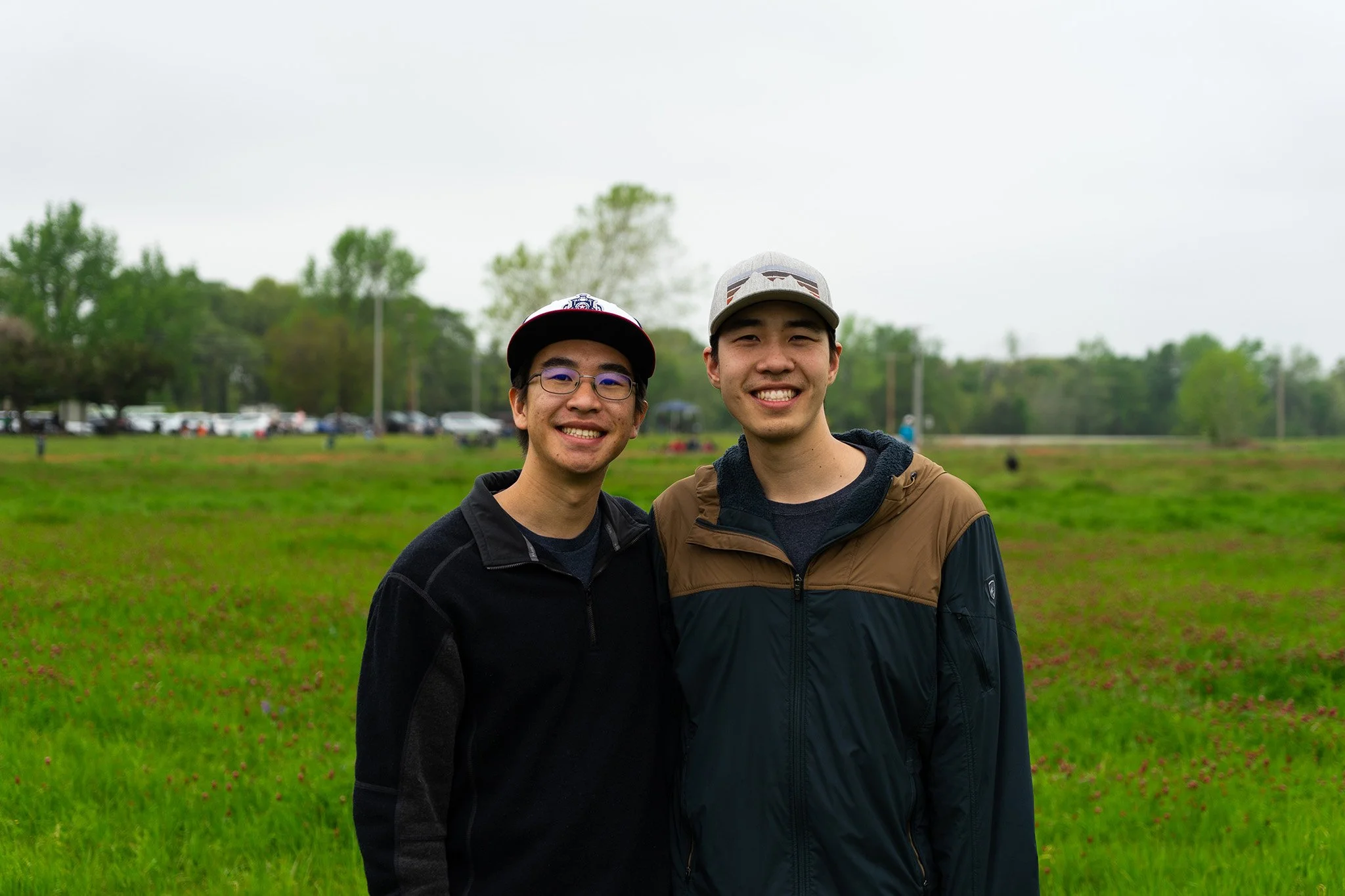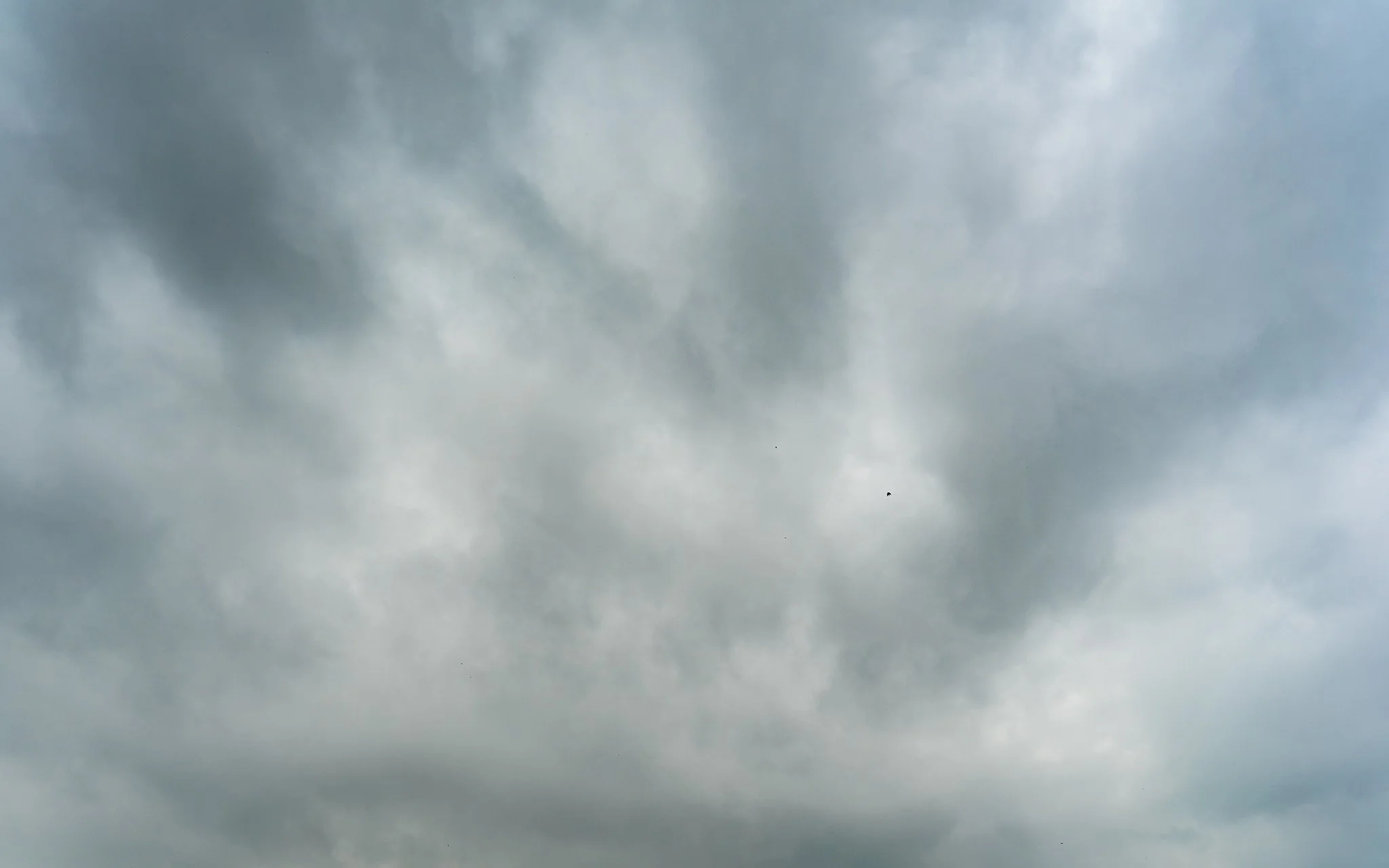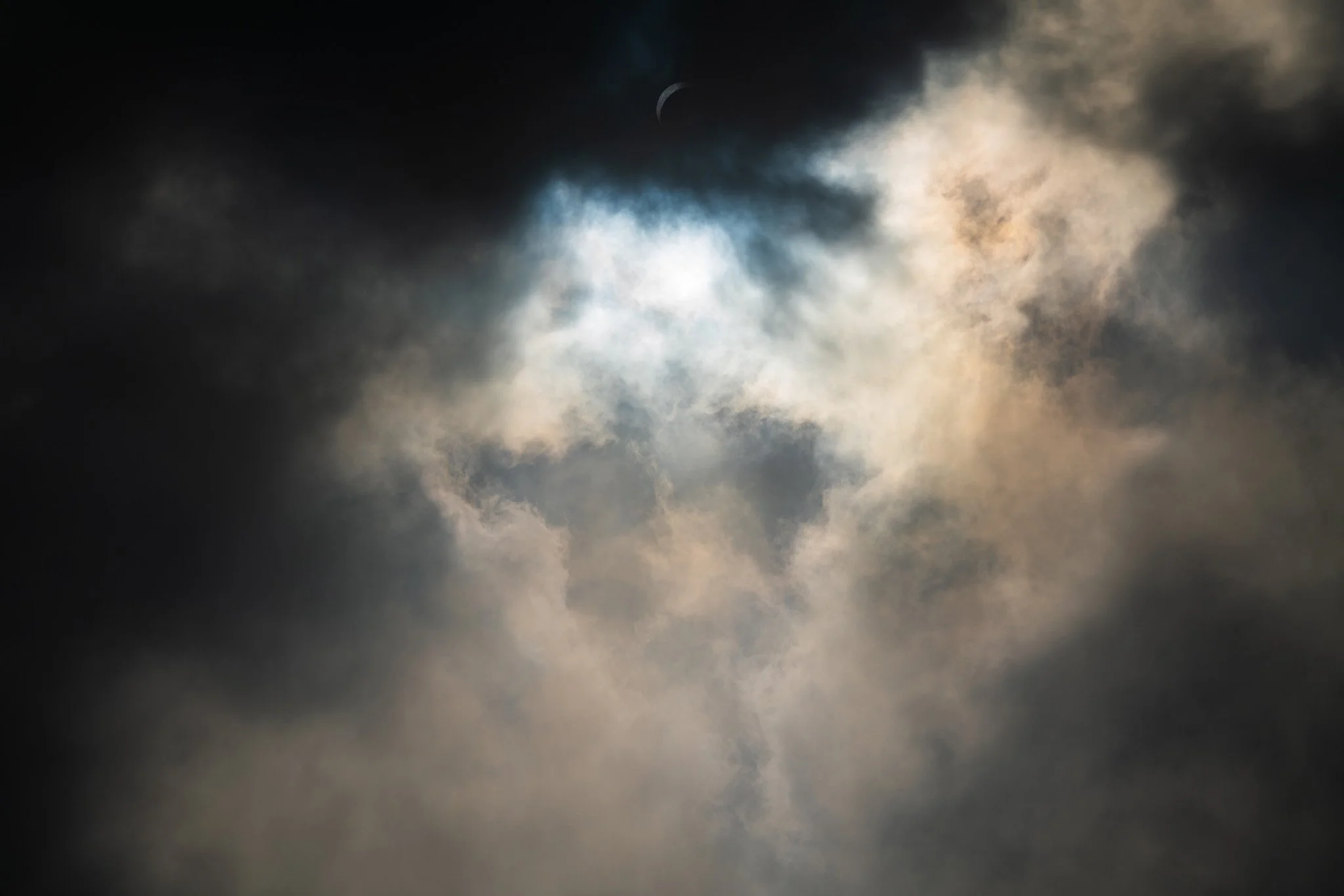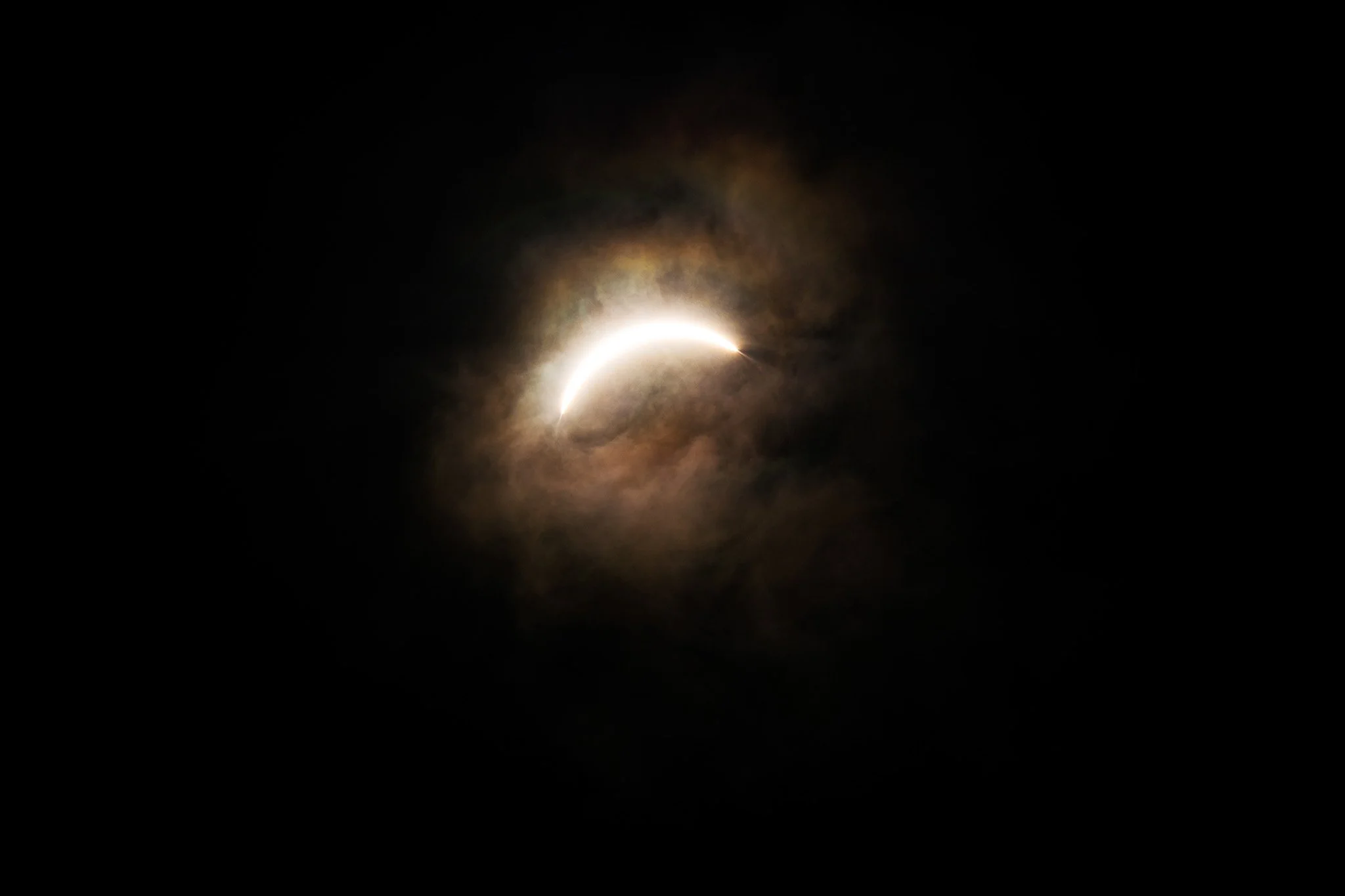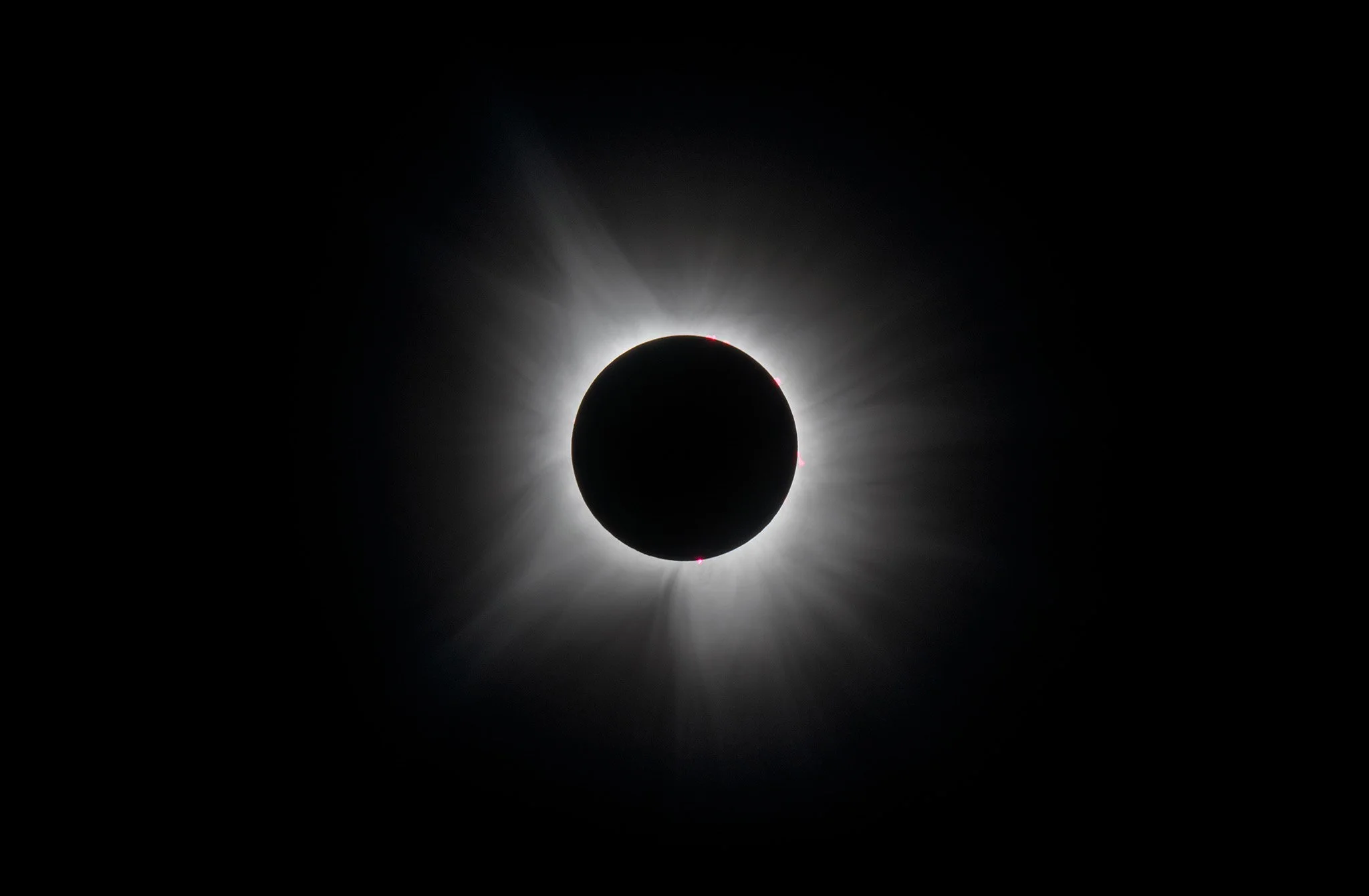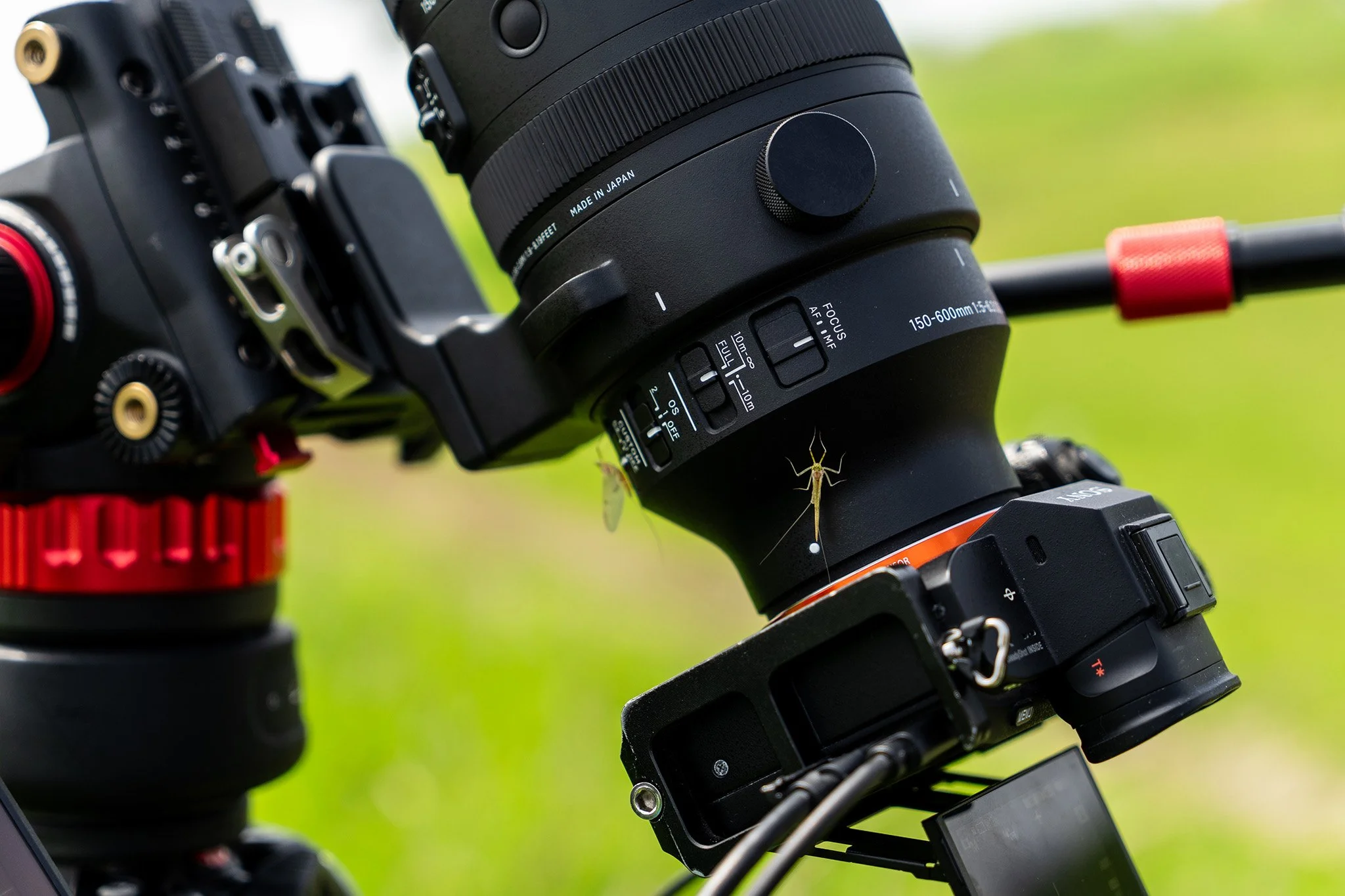Photographing the 2024 Total Solar Eclipse
Total Solar Eclipse in Hugo, OK with the sun just peeking out | Sony Alpha a7R II + Sigma 150-600mm @ 559mm, f/6.3, ISO 320, 1/60 sec
After seeing the 2023 annular solar eclipse and reading/watching all about the 2017 total solar eclipse, I was excited to have the opportunity to see the 2024 total solar eclipse. This total solar eclipse would cross the US from Texas to Maine with the longest duration of totality in Texas and the lowest degrees above the horizon in Maine. When planning where to go, it could have been nice to see the eclipse in Maine where there could be a possibility of framing the sun/moon against a foreground object; although, at 36 degrees above the horizon, it would still be hard to find a suitable subject. I did not bother looking into this option since the mean cloud fraction showed that there is a historically higher probability of clouds in Maine during this time of year versus Texas.
My brother and I before the eclipse
With that in mind in addition to the fact that my brother already lives in Texas, I figured it would be better to play it safe and go to a location that has been historically less cloudy. While any open area would work as a viewing spot, I ended up looking at various state parks within a couple hours’ drive. To get a spot at a Texas State Park, the online portal opens a month before the reservation date at 8 am Central Time; and since I live in California, I woke up at 6 am Pacific Time on March 8th to try and book a reservation. Within minutes of the reservations being open, almost all the slots for all the Texas State Parks within the path of totality were sold out. While I was not able to get a reservation at my first choice, I was able to get a reservation to another one. This state park was located just southwest of Waco and within a reasonable drive from our location in Austin.
Aside from planning our location, I also tried to make sure I was prepared photography wise. Since totality would happen so high in the sky (66 degrees above the horizon), I knew that there would not be a good opportunity to photograph the eclipse with a foreground structure like I did with last year’s annular solar eclipse; thus, I planned on using a longer focal length so I could fill more of the frame with the sun and moon. Additionally, I got a new solar filter that would clamp over the end of my lens rather than screwing onto the filter thread. I wanted to make sure I would be able to quickly take off my solar filter just before totality and not miss a moment trying to unscrew the filter from the lens’ front filter thread.
In the week leading up to the eclipse, the weather was looking to be cloudy with a possibility of thunderstorms on the day of the eclipse. Ironically, the forecast was shaping up to have clear skies in Maine. Regardless, the weather forecast a week in advance still could change, so I was holding out hope that a later forecast would show more favorable conditions. While some people were able to book a flight elsewhere, we did have some other obligations in the days leading up to the eclipse in Texas.
On Saturday, when we were driving through Waco, we stopped to visit the state park that we had a reservation for in addition to another nearby park. While they both would have offered a spot to see the eclipse, the weather forecast was not looking good for either of them. Now that we were within 48 hours of the eclipse, I was able to start looking at the NOAA’s HRRR weather forecast which is a short range, hourly updated weather model which makes it good for seeing how conditions are evolving closer to the time of the event than a standard medium range forecast model.
HRRR weather forecast on April 7th at 3:43pm
HRRR weather forecast on April 8th at 9:56am
Looking at the forecast, it looked like there was a better probability to see totality in the northeastern part of Texas. And while it looked to be more favorable in Arkansas, it would be a little too far to drive there for us. If we had to have clouds present during totality, it would be better to have high elevation clouds so that we might be able to see through them opposed to thicker lower elevation clouds that would block out the view. The clouds in that area were forecasted to be the higher elevation ones. So, on Sunday evening, we drove to Plano, TX (just north of Dallas) with plans to drive east in the morning.
Upon waking up early on eclipse day, there were clear skies outside our hotel window; but as we were getting ready, we saw some high elevation clouds that moved in and covered most of the sky. Looking at the updated forecast in the morning, I decided that it would be better to drive northeast to Paris, TX which looked to be just north of the bank of clouds.
Cloudy skies on our drive to Paris at 9:58am
Halfway along the drive to Paris, we were greeted with perfectly clear skies. It might have been tempting to stop and wait for the eclipse; however, we only care about clear skies during totality – not any other period of time leading up to it. So, trusting the forecast, we kept on driving. As we entered Paris and found our spot at a local city park, the skies were fully covered with low elevation, stormy looking clouds. We sat in the car and made our sandwiches for lunch while feeling quite concerned about our eclipse viewing chances. After eating lunch, we looked at the clouds above us and the updated forecast. The forecast did not paint a favorable picture for clear skies compared to just a few hours ago. Instead, the clearing in the clouds that we had initially seen in the forecast was now positioned further north.
Cloudy skies and some birds overhead with 18 minutes until totality
With just over two hours until totality, we decided to move again. Given the rarity of solar eclipses and having already driven so far, we decided it was worth a shot to go to another location and at least we could say we tried with our best available information. So, we started driving north towards a Walmart parking lot in Hugo, Oklahoma. The hope of clear skies in a Walmart parking lot sounded a lot better than cloudy skies in a nice park. Along the way, we realized there was a nice nature area not much further down the road near the mouth of a lake. To my surprise, we were able to find parking quite easily even though we only arrived about 30 minutes before the time that the partial phase of the eclipse would begin.
This location was the prettiest of all our past spots. There was a large, open grassy field without any obstructions and a handful of pretty flowers too. The only problem was that it was still cloudy. With just under 2 hours to go until totality, it was hard to feel optimistic for our odds, but all we could do was hope and pray that the clearing shown in the forecast would translate to a gap for us to see totality. And with 18 minutes until totality, I was not feeling very confident in our chances. The sky was still covered in mostly thick, gray clouds. Unlike when we arrived where the sky was just uniformly gray color, at least we could see some spots of light and dark.
My camera setup for the eclipse
In the time before totality, I set up my camera and tried to verify everything was working properly. Aside from using a longer lens this time around, I also connected an external monitor so that I could check my focus easier compared to looking at the small screen on the back of my camera. Additionally, I used a large V-Mount battery to power both the camera and monitor so that they would last without running out. I had a small hiccup where I could not find the screw used to connect my battery plate to my monitor. Ultimately, my brother suggested I just take a screw off another part where I had used two screws and just use one screw in both locations. After connecting all the cables, there was not much to practice before totality since I could not see the sun to set my focus or zoom on my lens.
A glimpse of the partial eclipse with 10 minutes until totality | Sony Alpha a7R II + Sigma 150-600mm @ 150mm, f/5, ISO 100, 1/1000 sec
As we were watching the clouds move above us, we caught a couple glimpses of the partial eclipse through the clouds that only lasted about few seconds at a time. Since I had a narrow field of view with my telephoto lens, it was quite challenging to point my camera at where I thought the sun was behind the clouds and then try to quickly reframe my photo when the sun would peek out. I opted for a wider field of view so that it would be easier to frame my photo, and I do quite like the extra context of the clouds that the wider field of view provides. Also, there were still so many clouds that there was no need to use a solar filter.
At about 7 minutes until totality, our excitement was building as the glimpses of the partial eclipse started becoming more frequent. And with a few minutes until totality, I saw this medium sized hole where the clouds were starting to part about 30 degrees to the right of the sun/moon. Through this hole, I could see the clear blue sky. I remember making a remark saying that it would be nice if that hole would move over a little bit.
A cloud moves in front of the partial eclipse with 1 minute until totality | Sony Alpha a7R II + Sigma 150-600mm @ 571mm, f/25, ISO 100, 1/1250 sec
Sure enough, the clouds magically started moving away, and I could not believe it. Seeing the clouds clear out was quite exciting. While most of the clouds cleared up by a couple minutes before totality, there were still some small patches of clouds that quickly passed in front of our view of the partial eclipse. I liked this photo of the partial eclipse shining through some clouds which I thought added a unique part to the photo rather than similar ones I took with the clear sky. I was also quite excited that I could see the silhouette of the moon as we were getting closer to totality.
Total Solar Eclipse in Hugo, OK | Sony Alpha a7R II + Sigma 150-600mm @ 559mm, f/25, ISO 100, 3/10 sec
Once totality came, we were treated to such an amazing view in addition to an unbelievably clear sky. I looked at so many pictures of totality and listened to many people’s stories, but there is nothing quite like experiencing it ourselves. The sky turned dark, and it looked like a hole in the sky with the white light of the Sun’s corona appearing around it. On the perimeter of the eclipse, we could see the sun’s pink color solar prominences.
After I took my photos of totality, I made sure to take my eyes off my camera screen and look around at my environment. While I did not take a photo, it was pretty cool to see Venus visible in the sky. Then, I got ready again to take photos as the sun would start peeking out again. Just before the end of totality, there were some thin clouds passing overhead, and I captured what I think was my favorite photo of the day (at the top of this blog post). After that, the sky got brighter as the sun came out, and it felt like daytime again.
It was quite a rollercoaster of events and emotions as we tried to find clear skies to see totality. The weather and light conditions changed so much in such a short time. I went from embracing the fact that we might not see anything to being quite excited as we experienced totality. The experience of totality was quite different than what I experienced for annularity last year. The sky was darker, and I could freely look around without the need for any solar eclipse glasses.
Mayfly on my camera after the eclipse
After totality, we stuck around as we were processing what had just happened. I was looking at my camera, and noticed there were a couple of mayflies that had landed on my lens. I imagine they must have come out during totality thinking it was nighttime.
Overall, I am quite happy with how my photos turned out especially considering that it felt like I messed up some technical details during totality. Unlike last year’s annular solar eclipse, I did not have time to practice my framing and focus due to the cloudy skies learning up to totality. Instead, I ended up setting my focus on some distant trees along the horizon while it was still cloudy. Just like shooting at sunset, I had my camera on aperture priority mode so that it would automatically select the shutter speed after setting my aperture, ISO, and exposure compensation. And once the clouds started clearing up, I did not really double check my settings as everything was happening so quickly. And being in the moment of totality, I ended up taking pictures with a longer exposure rather than opening my aperture up to let more light in as it grew darker.
Afterwards when I was looking at the metadata of my photos, I realized that my focal length was never quite at 600mm. This was my first time using this Sigma lens, and I did not remember to set the zoom stiffness setting properly. On the side of the lens, there is a zoom toggle switch with three settings. One is to lock the lens while traveling, and the other two are for the stiffness of the zoom. When setting up my camera, I just slid the toggle all the way to the third position which happened to be the loosest zoom setting. Upon pointing my camera upwards, I noticed that the weight of the lens was causing it to contract. My solution was to use some gaff tape to keep the lens from zooming out rather than just changing the setting on the lens. The gaff tape did work well; however, I ended up undoing it upon seeing the first glimpses of the sun through the clouds so that I could zoom out. This made it easier to find the sun within the camera’s field of view. When the clouds started to clear up and I zoomed back in, I forgot to retape the lens.
Family photo after totality
Regardless of some technical details I missed on, I still was able to come away with sharp photos that I was happy enough with. In the end, it is not just about the photos, but also about experiencing totality. And I am thankful to have experienced it with my family.
During our trip to see the eclipse, we had a memorable interaction with another eclipse hopeful viewer. When we were in the parking lot in Paris, we were just packing up and getting ready to go to our new location in Hugo when the couple parked in the adjacent spot asked us where we were going. I showed them the cloud forecast overlayed on a map and our new planned location in addition to the other spot that they were considering. Looking at the forecast, driving north to Hugo seemed to have better odds than going east. Turns out that we both went to the same spot in Hugo. While I noticed that they had a California plate, they told us it was a rental car and that they had flown in from North Carolina. And they made quite the journey as they left San Antonio at 4am. It was nice to share that small conversation with them and then see them smiling after experiencing the eclipse with clear skies too.
Overall, our total solar eclipse trip was a success even though it did not feel that way in the time leading up to totality. When planning for this trip and even the morning of the eclipse, I was so set on finding the perfect spot in Texas that I did not consider Oklahoma as a possibility. In fact, I had not heard of Hugo until I was looking at the weather and where we should go while sitting in the parking lot in Paris. Somehow, as we tried to follow the weather forecast, we ended up in Oklahoma, and it was better than I could have planned. While my initial plans did not exactly work out, I would not change anything that happened. And I could not be happier to have seen totality in Oklahoma. All my concerns of having too many people, trees, or clouds ended up being laid to rest. And we were able to enjoy the total solar eclipse. I am thankful for the clear skies that we had; then, on the way back to Austin, we experienced the rain and lightning as the forecast predicted.
Finally, thank you for reading probably my longest blog post to date. I hope you enjoyed hearing my stories and seeing the photos that I took!
